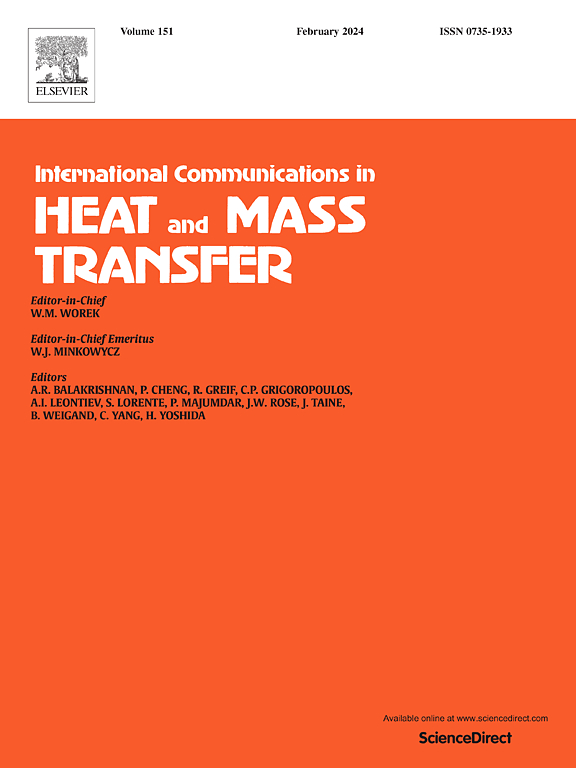基于物理信息的神经网络增强物质点法用于固体推进剂的回归和传热建模
IF 6.4
2区 工程技术
Q1 MECHANICS
International Communications in Heat and Mass Transfer
Pub Date : 2025-07-18
DOI:10.1016/j.icheatmasstransfer.2025.109320
引用次数: 0
摘要
本文提出了一种模拟固体复合推进剂回归过程的物质点法。通过采用物理信息神经网络求解气相化学反应,结合一种新的气固耦合方法,我们的方法准确地模拟了推进剂燃烧速度,同时捕捉了不同压力下复杂的固相界面形态。传统的MPM通常用于大变形模拟,通过我们的启发式数据驱动方法得到增强,实现了预测燃烧建模。对纯AP、AP/HTPB夹层结构、AP/HTPB填充推进剂和不同AP尺寸分布的AP填充推进剂的模拟结果显示,燃烧速率具有固有振荡。结果表明,与实验数据相比,在4 MPa以下误差为10%,在4 - 7 MPa之间误差为20%。精细热电偶测量的表面温度与实验结果偏差≤15%,从而验证了模型的预测能力。该方法的多物理场跟踪能力能够精确模拟复杂的界面形态,包括夹层推进剂中的低压胶粘剂层凹陷和高压突出,以及AP球形填料配置中的地下结构。该研究为预测复合推进剂燃烧速率和界面形态提供了一种新方法,未来的工作旨在改进基于实验见解的能量平衡算法和参数设置。本文章由计算机程序翻译,如有差异,请以英文原文为准。

A physics-informed neural network-enhanced material point method for regression and heat transfer modeling of solid propellant
In this study, we introduce a Material Point Method (MPM) for simulating the regression process of solid composite propellants. By employing a physics-informed neural network for solving gas-phase chemical reactions combined with a novel gas–solid coupling approach, our method accurately models the propellant burning rate while capturing complex solid-phase interface morphologies under various pressures. Traditional MPM, typically employed for large deformation simulations, is enhanced by our heuristic, data-driven approach, enabling predictive combustion modeling. Simulations of pure AP, AP/HTPB sandwich configurations, AP/HTPB-packed propellants, and AP-packed propellants with different AP size distributions revealed non-steady state burning rates with inherent oscillations. Our results showed 10% error below 4 MPa and 20% error between 4–7 MPa compared to experimental data. Fine thermocouple measurements of surface temperatures showed 15% deviation from experimental results, thereby validating the model’s predictive capability. The method’s multi-physics tracking capability enables accurate simulation of complex interface morphologies, including low-pressure adhesive layer depressions and high-pressure protrusions in sandwich propellants, as well as subsurface structures in AP spherical packed configurations. This research provides a new method for predicting the burning rate and interface morphology of composite propellant combustion, with future work aimed at refining energy balance algorithms and parameter settings based on experimental insights.
求助全文
通过发布文献求助,成功后即可免费获取论文全文。
去求助
来源期刊
CiteScore
11.00
自引率
10.00%
发文量
648
审稿时长
32 days
期刊介绍:
International Communications in Heat and Mass Transfer serves as a world forum for the rapid dissemination of new ideas, new measurement techniques, preliminary findings of ongoing investigations, discussions, and criticisms in the field of heat and mass transfer. Two types of manuscript will be considered for publication: communications (short reports of new work or discussions of work which has already been published) and summaries (abstracts of reports, theses or manuscripts which are too long for publication in full). Together with its companion publication, International Journal of Heat and Mass Transfer, with which it shares the same Board of Editors, this journal is read by research workers and engineers throughout the world.

 求助内容:
求助内容: 应助结果提醒方式:
应助结果提醒方式:


